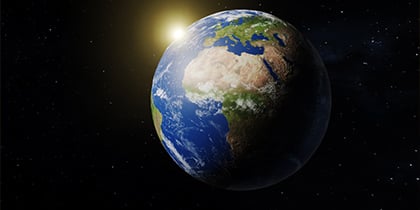Earth Overshoot Day marks the moment when we consume more resources worldwide than the Earth can renew in the same year. In 2025, this day will fall as early as July 24.
A confrontational date that falls a little earlier each year. The urgency is rightly emphasized on this day. But just as important is the question: how do we translate that urgency into concrete actions?
That's what we asked our sector leads. What step could each company take tomorrow to contribute to reducing Earth Overshoot Day- towards December 31? You can read the answers in this blog.

Concrete actions for the manufacturing industry to reduce resource consumption
The manufacturing industry consists of companies that produce physical products-from machinery and auto parts to electronics and furniture.
This type of production requires large quantities of materials, such as metals and plastics. Many of these materials come from finite resources- raw materials that do not replenish themselves, such as petroleum.
''This is precisely why there is an opportunity in this sector to reduce Earth Overshoot Day,'' said Paula van Hoorik, Team Lead Industry & Mobility. ''That starts at the front end of the production process, by using recycled materials. At the back end, it's important to make sure that used materials don't unnecessarily end up as residual waste-but are collected and reused that way.
Focusing on sustainable design also offers opportunities. By designing products in such a way that parts can be easily detached, materials can be more easily separated after use. Think of screw connections instead of glue. This makes it easier to reuse valuable materials. This results in less waste and less need for new raw materials.
In practice: from residual waste to reusable raw materials
This example shows how used materials do not unnecessarily end up as residual waste.
At Isobouw, manufacturer of insulation solutions, a large volume of wood was disposed of as residual waste for years. The reason: the wood was contaminated with EPS (polystyrene foam), which is difficult to separate and disrupts the recycling process. As a result, the entire stream could not be reused. 
In cooperation with Isobouw, Milgro mapped this wood stream in detail. This showed that the EPS already stuck to the wood during production, and that collection and storage amplified contamination. These insights were the starting point for targeted optimizations. Our Waste Engineers investigated sustainable solutions and worked them out in a substantiated business case.
Based on this advice, Isobouw adapted the production process, and a processor was chosen that can process the wood stream into biomass. Milgro connected the waste collection to this, so that the wood can be delivered separately. The result: this stream is no longer disposed of as residual waste, but reused as a reusable raw material.
What can you do tomorrow to reduce Earth Overshoot Day?
Changing a production process - as in the example of Isobouw - takes time and preparation, and therefore cannot be done overnight. Yet you can start tomorrow. After all, the first step toward using raw materials more efficiently does not have to be a big one.
It starts with insight. What waste is released at your company site-and now ends up unnecessarily in residual waste? In the #zerowastechallenge you and your colleagues get to work on that. Collect, weigh and analyze the waste that is released at your company site. Discover how you can better separate your waste streams from now on, so they can be reused as raw materials. Practical, fun and effective.
Wondering how your organization can handle waste streams more efficiently? 
Contact Paula van Hoorik, Team Lead Industry & Mobility, and discover how you can reduce your waste streams, separate them better and reuse them more effectively.

Concrete actions for the logistics sector to reduce raw material consumption
The logistics sector plays an important role in moving goods - from producer to customer. Waste is generated at every stage of the process: in receiving, storing, shipping and returning. Consider pallets, packaging, padding and labels. Large quantities of boxes, film and stickers are used daily - often for one-time use. Afterwards, they often end up in residual waste.
A shame, because many of these materials can be reused or recycled. By better separating waste streams and giving reusable materials such as cardboard a second life, logistics companies can contribute to saving raw materials. And thus help reduce Earth Overshoot Day.
What that looks like in practice is demonstrated by the example of PostNL Amsterdam.
In practice: PostNL Amsterdam reduces residual waste with new collection structure
At the letter sorting location, for a long time a large part of the waste-paper, cardboard and plastic-was thrown away with the residual waste. The result? As much as 78% of the waste ended up in the residual waste container.
In cooperation with PostNL , Milgro changed this. A new collection structure was set up, including 140 new collection tools and clear instructions on the shop floor. This made it easier for employees to separate waste streams directly in the right place.
What can you do tomorrow to reduce Earth Overshoot Day?
We asked Pim Louer, Team Lead Logistics & Retail.
''Optimizing waste separation starts with awareness: knowing which waste belongs where. Our posters help you do that. They are tailored to specific types of waste and designed to show employees at a glance what belongs where''. Download the posters for free and hang them up on your shop floor - a low-threshold step you can take tomorrow.
He also listed the following practical tips for your logistics organization.
- Reuse cardboard from incoming deliveries as padding material
Many goods that organizations receive are packed in cardboard boxes. This cardboard is often thrown away immediately. By reusing it as padding material in outbound shipments, you reduce waste as well as save on purchasing new padding material.
- Don't throw the back of labels in the garbage
The back of labels - the smooth paper that holds the stickers - is often thrown away with residual waste. A shame, because this material is often recyclable. By collecting it separately, the material can be reused. For example, did you know that the material can be processed into new products such as toilet paper?
- Switch to reusable coffee cups
Disposable cups are used in many logistics environments. By giving employees reusable cups, you prevent unnecessary waste. We also applied this at Milgro by giving each colleague a personalized mug.
- Make use of reverse logistics
Reverse logistics means that materials or products are taken back to the distribution center so that they can be reused. For example, consider reusable crates used when delivering groceries. Customers return these to the next delivery and they are reused.
You can also apply this within your own supply chain. A recognizable example is the use of pallets. These often end up in the residual waste after just one use. A shame, because it leads to unnecessary loss of material and extra costs for purchasing new pallets.
Therefore, see if you can reuse pallets within your own logistics process or recover them via a return flow - for example, by taking them back with the next delivery. This way you keep pallets in the cycle, save raw materials and prevent waste.
Curious about the possibilities for more efficient use of raw materials within your organization? Feel free to contact Pim Louer, Team Lead Logistics & Retail, and discover how you can reduce your waste streams, separate them better and reuse them more effectively.
Feel free to contact Pim Louer, Team Lead Logistics & Retail, and discover how you can reduce your waste streams, separate them better and reuse them more effectively.

Concrete actions for the food industry to reduce raw material consumption
Every year, over a third of all food is lost worldwide. This is not only a moral problem, but also an important issue within the resource transition. Because every food produced requires land, water, energy and often packaging materials. In the food industry in particular there is therefore a great deal of potential for reducing waste and using raw materials more efficiently.
One effective way to do that is to reuse residual streams for human consumption - also known as Food for Food. ''The idea behind this is simple: what remains after the production, processing or consumption of food is given a new purpose,'' says Alex van Kuilenburg, Team Lead Food.
How exactly this works is illustrated by a practical example.
In practice: residual flows from nut and sauce production as food ingredients
In the production of nuts, peanut butter and peanut sauce, residual streams such as peanut dust and husks are created. Before the cooperation with Milgro, these often ended up as animal feed or were fermented.
Thanks to our expertise and innovative supply chain partners, these streams got a new destination as food ingredients, for example in vegetable oils or breakfast products. Proof that food and food waste that is not suitable for consumption can still be valuable.
The result? Less waste, lower costs and ecological gains.
Packaging material: from incineration to recycling
There are also opportunities within the food industry's packaging chain to save raw materials. A good example is the situation at Aviko Proven, a producer in the potato industry. The organization faced the challenge of disposing of plastic films in a sustainable manner. Traditional waste disposal led to incineration, which was not in line with the organization's sustainability goals.
Together with Milgro, Aviko Proven set out to find an environmentally friendly solution for processing foils. The solution? Chemical recycling--which reduced the amount of residual waste by nearly 70% within a year, as well as achieving significant cost savings.
What can you do tomorrow to reduce Earth Overshoot Day?
The examples above call for structural changes--which you won't achieve overnight. But are there steps you can take as early as tomorrow. For example, start small, with a worm hotel at your office.
In a worm hotel, compost worms convert vegetable and fruit scraps into valuable compost. The worms live just below the surface and specialize in digesting fresh organic waste. What they excrete is a fine, crumbly compost-rich in nutrients for plants and soil.
live just below the surface and specialize in digesting fresh organic waste. What they excrete is a fine, crumbly compost-rich in nutrients for plants and soil.
Because the system requires little space, gives off no odor and is easily applicable locally, more and more companies, schools and municipalities are choosing this form of circular waste disposal. In this way, you immediately give GFT waste a new function, without it ending up in the residual waste container.
Adding worm composting on a large scale? Keep in mind the changing laws and regulations. In this blog, we share all the ins & outs.
Practical tips
''In addition to the worm hotel, I like to share two practical tips, based on practical experience,'' said Alex van Kuilenburg, Team Lead Food.
- Keep products with packaging errors separate
Products with a crooked label or wrong wrapping are often rejected immediately. Think: cookies with a crooked label, or chocolate bars with a wrapper of the wrong flavor. A shame, because they are often still perfectly usable. By keeping these products separate, you can investigate whether you can use them internally (for example, in the canteen) or offer them as raw material for new food products.
- Place a crate for usable waste streams from production
Residual flows such as leftover dough left in the mixing kettle often automatically disappear into the waste. By temporarily keeping them separate in a crate or bucket - preferably refrigerated or emptied daily - you gain insight into exactly how much is released. That is the first step in determining whether the stream is suitable for processing into food ingredients.
Need help or curious about the possibilities for your waste streams? Feel free to contact  Alex van Kuilenburg, Team Lead Food.
Alex van Kuilenburg, Team Lead Food.











